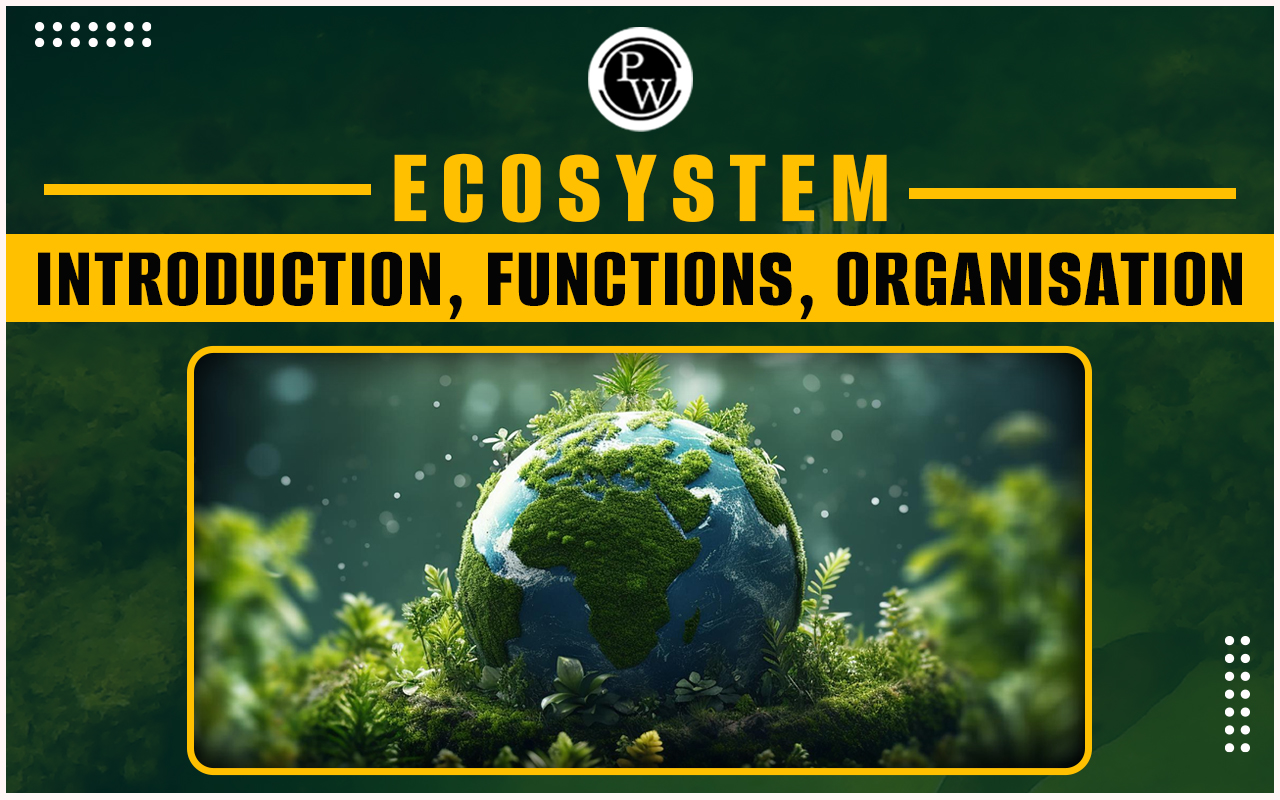

An ecosystem is an area where different types of living things coexist peacefully to form a "biome of life." Both biotic (or alive) and abiotic (or nonliving) elements make up ecosystems. Biotic variables include all living things, including plants, animals, and other organisms. Things like rocks, temperature, and humidity are examples of abiotic variables.
Every element in an ecosystem is directly or indirectly dependent on every other element. For instance, the plants that may thrive there are regularly impacted by changes in ecosystem temperature. Animals that rely on plants for both food and shelter must adapt to the environment, find other habitats, or become extinct. This article will discuss the ecosystem's components, functions, types and threats.Ecosystem
The term "ecosystem" refers to a structural and functional component of the biosphere in which biotic and abiotic elements interact through the food chain, food web, chemical cycles, etc. Tansley first used the term "ecosystem" in 1935. All living creatures must rely on one another to survive. Everything that is alive depends heavily on its environment. To exist and maintain the natural order, all living things—including plants, animals, and microorganisms—depend on non-living materials. It is this interaction between living and nonliving elements that the ecosystem deals with. As a result, the ecosystem is the fundamental building block of the natural world.- Ecosystems come in a variety of sizes. Tide pools are complete, miniature ecosystems created as the tide recedes and leaves behind ponds. An algae variety called seaweed develops in tidewater and generates nourishment via the photosynthesis process.
- Herbivorous creatures like abalone consume seaweed. Sea stars and other carnivorous organisms like them consume clams and mussels found in the tidal pool.
- The fluctuating ocean water level affects tide pools. An algae species called seaweed thrives in tidal pools and uses photosynthesis to provide food.
- Hermit crabs and other species that cannot survive underwater rely on the shallow pools that low tides leave behind. In this approach, abiotic influences influence the biotic components of the ecosystem.
Classification of Ecosystem
1. Terrestrial Ecosystem:
- An ecosystem on land is called a terrestrial ecosystem. Consider the ecosystems of a forest, grassland, desert, and tundra.
- A Forest ecosystem comprises trees, plants, animals, microbes, soil, water, wind, etc. It encompasses coniferous, tropical, and deciduous woods.
- A sizable region covered with grasses and non-woody plants is known as a grassland ecosystem. It excludes larger plants and trees. Because they are low on the earth, grasses require less water to develop. Their thick roots enable them to endure harsh environments. Temperate grasslands, Savannah, shrublands, etc., are all included.
- The tundra ecosystem is the coldest and harshest on the planet. These environments lack trees and are encircled by ice and snow.
- Less rain(less than 10 inches), falls annually on desert ecosystems. Low or inadequate moisture levels characterise these areas.
Related Links -
2. Aquatic Ecosystem:
The ecosystem that is found in water is referred to as an aquatic ecosystem. Sea and freshwater ecosystems are two examples.- 1. Freshwater Ecosystem - Water that has less salt and is constantly cycling is called freshwater. There are two primary varieties: lentic (still water, like a pond) and lotic (moving water, like a river).
- 2. Marine ecosystem - The water in this habitat is highly salinated. Think about vast oceans and shallow waters.
The Organisation of the Ecosystem
Two terms make up an ecosystem: "eco" stands for habitat, and "system" stands for the interrelated processes or elements of the environment. It is the biosphere's functional unit. There are two parts to ecology. These are:1. Biotic Elements
- All living things, including plants, animals, and microbes, are included. The following groupings can be used to categorise or separate biotic components:
- All plants producing food using resources like sunshine, water, and carbon dioxide are called autotrophs or producers. Photosynthesis is the name of this process. Any living thing that produces chlorophyll is capable of photosynthesis.
- All heterotrophs, especially animals, who depend on producers, are considered consumers. It is further divided into the following groups:
- All herbivores, such as cows, goats, rabbits, lambs, and other animals directly reliant on plants, are considered primary consumers.
- All carnivorous species that rely on main consumers for food are considered secondary consumers.
- All omnivorous animals are considered tertiary consumers. These creatures have adaptable eating habits, allowing them to consume plants and animals.
- Decomposers are microorganisms, such as bacteria and fungus, that eat decaying and dead substances to get food. They are additionally known as probiotic microbes. They may be saprozoic or saprophytic, feeding on dead plants or animals. It aids in environmental cleanup and ecosystem nutrient recycling.
2. Abiotic Elements
All non-living objects are included in it. These factors include wind, water, soil, light, temperature, precipitation, and humidity.Wind
Because it affects the rate of evaporation and transpiration, the wind is a significant abiotic element. In addition to moving the species that make up an ecosystem, the power of the wind also plays a significant role.Difference Between Plant Cell And Animal Cell
Water
Water is another crucial abiotic component. As someone once stated, no matter how wealthy you are, you cannot survive without water. All living things require water as a vital component. The world's surface is 71% water, while some creatures are 95% water.Atmosphere
The earth's atmosphere keeps life on the planet alive. Living things like plants, animals, and people get oxygen from the atmosphere. The four primary layers of the atmosphere are the troposphere, stratosphere, ozonosphere, and mesosphere.Temperature
Given that temperature changes affect plants and animals differently, temperature is a significant abiotic element. Yaks, for instance, dwell in cold climates with low temperatures, whereas camels live in hot climates with high temperatures.Chemical Substances
Chemicals make up all matter and play a significant role in the abiotic environment of living things. For instance, acidic soils are ideal for plants like Holly. Many species need certain metals, including copper, as micronutrients.Effects of Air Pollution On Environment
Functions of an Ecosystem
The ecosystem serves the following purposes:- It uses sunlight and inorganic nutrients as inputs and produces energy and waste as a product.
- It guarantees the transfer of nutrients among the ecosystem's constituent parts.
- The movement of energy from one trophic level to another is aided by it.
- It keeps up all of the ecosystem's crucial ecological processes.
- It offers numerous animals a place of residence.
Food Chain:
The term "food chain" describes a group of organisms passing energy from one creature to another by feeding. There are producers, consumers, and decomposers in a food chain. One trophic level is assigned to each one. Herbivores rely on producers directly since they are at the bottom of the food chain. Carnivores make up tertiary and secondary consumers.Importance of Food Chain
- Food chains is straight and unidirectional. 3–4 phases are usually included in one chain.
- There is just one direction in which energy flows or a unidirectional energy flow.
- An energy loss of 10% occurs at each step or trophic level. Due to this loss, a food chain can only have a maximum of 3–4 or 5 trophic levels. Less energy is available to organisms at the highest trophic level.
- When an organism dies, decomposers work on it, converting its complex proteins into simpler ones that plants may utilise for their growth and development.
Food Web
It pertains to several connected food chains. It develops when there is a food shortage in one food chain, at which point organisms go for food in another. The food chains are interlinked at different trophic levels, As a result, the food chain, collectively called the food web, becomes increasingly intricate and interconnected.Importance of Food Web
- The organisms forms multiple interactions for food.
- It offers an alternate method of obtaining nourishment.
- As a lack of food in one food chain may be made up by the presence of another, it increases the stability of the ecosystem.
Double Fertilization In Angiosperms
Ecological Pyramid
The term "ecological pyramid" refers to the pyramid-shaped visual depiction of an ecosystem's trophic systems. The pyramid's base is the largest, and producers are at the top.- The Pyramid of Energy is always upright and represents how energy transfers from one trophic level to another.
- The pyramid of numbers, which can be upright or inverted, shows how many individuals are in each trophic level.
- Each trophic level's dry weight is represented by a pyramid of biomass, which can be upright or inverted.
Effects of Air Pollution on Plants
Related Links -
Ecosystem <span style=
What function is served by the ecosystem?
An ecosystem is a species group interacting with abiotic and biotic elements. The ecosystem is the result of this biotic-abiotic interaction. Aquatic and terrestrial ecosystems are two examples of ecosystems.
What constitutes an ecosystem's structure?
An ecosystem's structure is determined by how its biotic and abiotic components are organised.
This includes how energy is dispersed across our surroundings. The climate that prevails in that specific environment is also included. An ecosystem has both biotic and abiotic elements that are interconnected.
What characteristics characterise the ecosystem?
The structures and functions of ecosystems and landscapes in their variation over time and space are referred to as ecosystem properties (e.g., soil characteristics, biotic material production, nutrient cycles, and biological diversity), and they serve as the foundation for society and any other type of service that humans can use.
What are producers in an ecosystem?
Any organism capable of photosynthesis is a producer. By absorbing sunlight and utilising the energy to create sugar, green plants produce their nourishment. This sugar, also known as glucose, is used by the plant to produce various materials, including wood, leaves, roots, and bark.
🔥 Trending Blogs
Talk to a counsellorHave doubts? Our support team will be happy to assist you!

Free Learning Resources
PW Books
Notes (Class 10-12)
PW Study Materials
Notes (Class 6-9)
Ncert Solutions
Govt Exams
Class 6th to 12th Online Courses
Govt Job Exams Courses
UPSC Coaching
Defence Exam Coaching
Gate Exam Coaching
Other Exams
Know about Physics Wallah
Physics Wallah is an Indian edtech platform that provides accessible & comprehensive learning experiences to students from Class 6th to postgraduate level. We also provide extensive NCERT solutions, sample paper, NEET, JEE Mains, BITSAT previous year papers & more such resources to students. Physics Wallah also caters to over 3.5 million registered students and over 78 lakh+ Youtube subscribers with 4.8 rating on its app.
We Stand Out because
We provide students with intensive courses with India’s qualified & experienced faculties & mentors. PW strives to make the learning experience comprehensive and accessible for students of all sections of society. We believe in empowering every single student who couldn't dream of a good career in engineering and medical field earlier.
Our Key Focus Areas
Physics Wallah's main focus is to make the learning experience as economical as possible for all students. With our affordable courses like Lakshya, Udaan and Arjuna and many others, we have been able to provide a platform for lakhs of aspirants. From providing Chemistry, Maths, Physics formula to giving e-books of eminent authors like RD Sharma, RS Aggarwal and Lakhmir Singh, PW focuses on every single student's need for preparation.
What Makes Us Different
Physics Wallah strives to develop a comprehensive pedagogical structure for students, where they get a state-of-the-art learning experience with study material and resources. Apart from catering students preparing for JEE Mains and NEET, PW also provides study material for each state board like Uttar Pradesh, Bihar, and others
Copyright © 2025 Physicswallah Limited All rights reserved.
Get App











